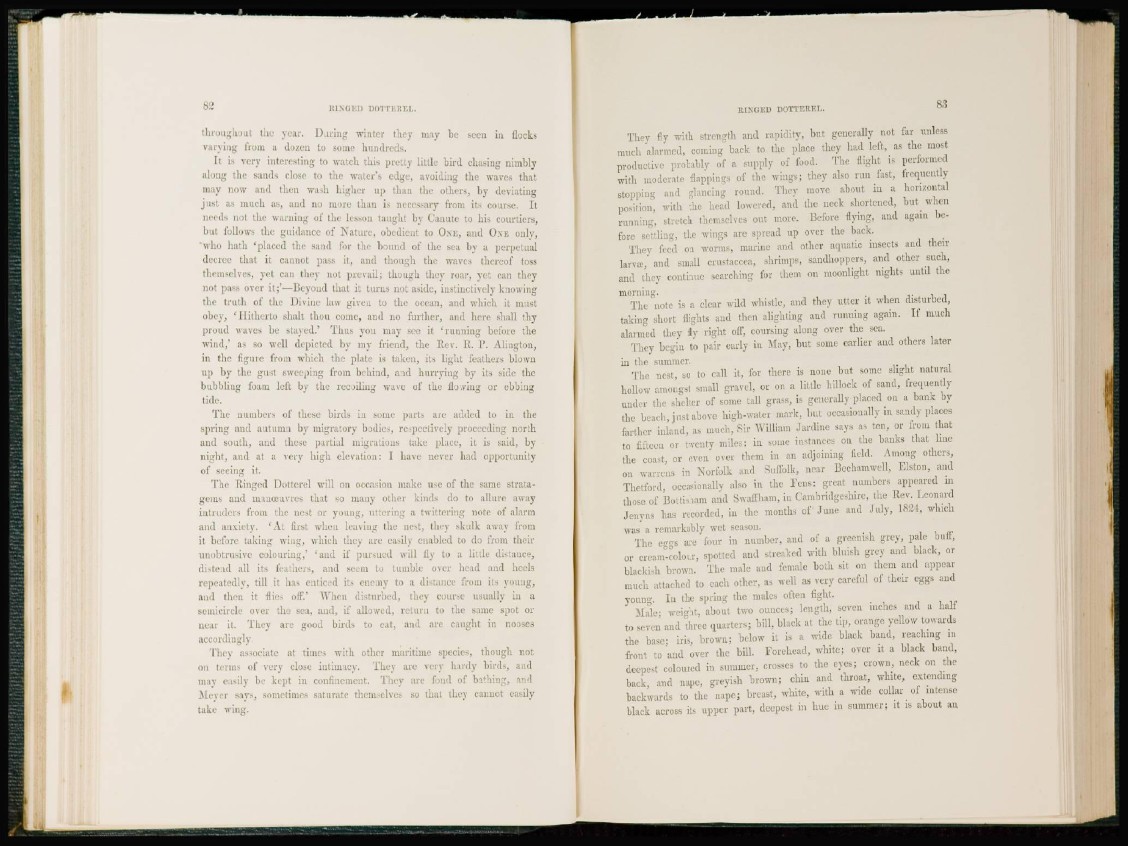
RINGED DOTTEREL.
throughout the year. Daring winter they may be seen in flocks
varying from a dozen to some hundreds.
It is very interesting to watch this pretty little bird chasing nimbly
along the sands close to the water's edge, avoiding the waves that
may now and then wash higher up than the others, by deviating
just as much as, and no more than is necessary from its course. It
needs not the warning of the lesson taught by Canute to his courtiers,
but follows the guidance of Nature, obedient to ONE, and ONE only,
who hath 'placed the sand for the bound of the sea by a perpetual
decree that it cannot pass it, and though the waves thereof toss
themselves, yet can they not prevail; though they roar, yet can they
not pass over it;'—Beyond that it turns not aside, instinctively knowing
the truth of the Divine law given to the ocean, and which it must
obey, 'Hitherto shalt thou come, and no further, and here shall thy
proud waves be stayed.' Thus you may see it 'running before the
wind,' as so well depicted by my friend, the Rev. 11. P . Alington,
in the figure from which the plate is taken, its light feathers blown
up by the gust sweeping from behind, a i d hurrying by its sick- the
bubbling foam left by the recoiling wave of the flowing or ebbing
tide.
The numbers of these birds in some parts are added to in the
spring and autumn by migratory bodies, respectively proceeding north
and south, and these partial migrations take place, it is said, by
night, and at a very high elevation: I have never had opportunity
of seeing it.
The Ringed Dotterel will on occasion make use of the same stratagems
and manoeuvres that so many other kinds do to allure away
intruders from the nest or young, uttering a twittering note of alarm
and anxiety. 'At first when leaving the nest, they skulk away from
it before taking wdng, which they are easily enabled to do from their
unobtrusive colouring,' 'and if pursued will fly to a little distance,
diste id all its feathers, and sevm to tumble over head and heels
repeatedly, till it has enticed its enemy to a distance from its young,
and then it flies off.' When disturbed, they course usually in a
semicircle over the sea, and, if allowed, return to the same spot or
near it. They are good birds to eat, and are caught in nooses
accordingly
They associate at times with other maritime species, though not
on terms of very close intimacy. They are very hardy birds, and
may easily be kept in confinement. They arc fond of bathing, and
Meyer says, sometimes saturate themselves so that they cannot easily
take wing.
RINGED DOTTEREL. 8;l
They fly with strength and rapidity, but generally not far unless
much alarmed, coining back to the place they had left, as the most
productive probably of a supply of food. The flight is performed
with moderate flappings of the wings; they also run fast, frequently
stopping and glancing round. They move about in a horizontal
position, with the head lowered, and the neck shortened, but when
running, stretch themselves out more. Before flying, and again before
settling, the wings are spread up over the back.
They feed on worms, marine and other aquatic insects and their
larva?, and small crustaccea, shrimps, saudhoppcrs, and other such,
and they continue searching for them on moonlight nights until the
morning.
The note is a clear wild whistle, and they utter it when disturbed,
taking short flights and then alighting and running again. If much
alarmed they fly right off, coursing along over the sea.
They begin to pair early in May, but some earlier and others later
in the summer.
The nest, so to call it, for there is none but some slight natural
hollow amongst small gravel, or on a little hillock of sand, frequently
under the shelter of some tall grass, is generally placed on a bank by
the beach, just above high-water mark, but occasionally in sandy places
farther inland, as much. Sir William Jardine says as ten, or from that
to fifteen or twenty miles: in some instances on the hanks that line
the coast, or even over them in an adjoining field. Among others,
on warrens in Norfolk and Suffolk, near Beehainwell, Els ton, and
Thetford, occasionally also in the Tens: great numbers appeared in
those of Bottisham and Swaffham, hi Cambridgeshire, the Rev. Leonard
Jenyns has recorded, in the months of June and July, 1824, which
was a remarkably wet season.
The eggs are four in number, and of a greenish grey, pale buff,
or cream-colour, spotted and streaked with bluish grey and black, or
blackish brown. The male and female both sit on them and appear
much attached to each other, as well as very careful of their eggs and
young. In the spring the males often fight.
Male; weight, about two ounces; length, seven inches and a half
to seven and three quarters; bill, black at the tip, orange yellow towards
the base; iris, brown; below it is a wide black band, reaching in
front to and over the bill. Forehead, white; over it a black band,
deepest coloured in summer, crosses to the eyes; crown, neck on the
back, and nape, greyish brown; chin and throat, white, extending
backwards to the nape; breast, white, with a wide collar of intense
black across its upper part, deepest in hue in summer; it is about an